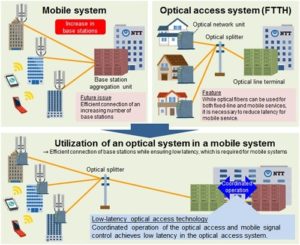Nippon Telegraph and Telephone Corporation (NTT; headquartered in Chiyoda-ku, Tokyo; President & CEO: Hiroo Unoura) has developed low-latency optical access technology that helps to reduce the number of optical fibers needed to accommodate base stations, especially during the period when the fifth and subsequent generation mobile systems are introduced. NTT has also conducted a feasibility trial in which the optical access system has operated in coordination with a mobile system.
This technology reduces data transmission latency which is an issue when applying optical access systems, which are widely used for accessing the Internet, to a mobile system. It is achieved by making optical line terminals and base station aggregation units in telecom office operate in coordination with the signal control.
Applying optical access systems with the technology to a mobile system, it becomes possible to efficiently use optical fibers between a telecom office and base stations. This reduces both the number of optical fibers required and the ports of the base station aggregation unit, enabling efficient operation of base stations. Detailed discussions on this technology have been initiated at ITU-T, a standardization organization
NTT is committed to ongoing R&D to help mobile operators in efficient construction of their networks.
The fifth generation (5G) mobile system is being developed to achieve a high-speed, high-capacity and low-latency mobile service. In the existing mobile system, optical fibers are used to connect the base station aggregation unit installed in a telecom office and base stations installed on towers or a top of buildings.
To achieve high-speed, high-capacity wireless communication, the 5G mobile system uses new radio frequency bands. This will require installation of more base stations than before, resulting in an increase in the number of optical fibers used to connect the base stations to the base station aggregation unit and in the number of ports for the base station aggregation unit. These increases are expected to complicate network operations, including fault recovery and maintenance. Therefore, especially during the period when the 5G system is expanding, requiring installation of numerous base stations, it is essential that base stations can be connected and operated efficiently.
Research result
An optical access system is employed to connect optical network units, which set up connections to user terminals and optical line terminals in a telecom office in a Fiber to the Home (FTTH) service. NTT has developed low-latency optical access technology to enable use of the optical access system in a mobile system.
The conventional optical access system cannot satisfy the low latency requirement demanded by the mobile system. The new optical access technology reduces this latency by making optical line terminals in the optical access system operate in coordination with the signal control by the base station aggregation unit.

In the case where the conventional optical access system is used, when an optical network unit receives data from a user terminal, it notifies the optical line terminal of the volume of data that it will transmit. It sends data to the optical line terminal only after it has received transmission permission. This causes a high latency before the optical network unit transmits data, which is why the conventional access system cannot satisfy the mobile system’s requirement for low latency.
In contrast, in the case where the new low-latency optical access technology is applied, the base station aggregation unit provides advance notification to the optical line terminal of the volume of data that will be sent by the user terminal. This is possible because the base station aggregation unit has been notified by the user terminal in advance of the volume of data that will be sent by the user terminal. By making the optical access system operate in coordination with the mobile system in this way, it is possible to omit the round trip procedures used in the conventional optical access system for notification of the amount of transmission data and for transmission permission, thereby achieving low-latency optical access.

The conventional optical access system cannot satisfy the low latency requirement demanded by the mobile system. The new optical access technology reduces this latency by making optical line terminals in the optical access system operate in coordination with the signal control by the base station aggregation unit.
In the case where the conventional optical access system is used, when an optical network unit receives data from a user terminal, it notifies the optical line terminal of the volume of data that it will transmit. It sends data to the optical line terminal only after it has received transmission permission. This causes a high latency before the optical network unit transmits data, which is why the conventional access system cannot satisfy the mobile system’s requirement for low latency.
In contrast, in the case where the new low-latency optical access technology is applied, the base station aggregation unit provides advance notification to the optical line terminal of the volume of data that will be sent by the user terminal. This is possible because the base station aggregation unit has been notified by the user terminal in advance of the volume of data that will be sent by the user terminal. By making the optical access system operate in coordination with the mobile system in this way, it is possible to omit the round trip procedures used in the conventional optical access system for notification of the amount of transmission data and for transmission permission, thereby achieving low-latency optical access.
Future plan
NTT will continue pursuing R&D to help mobile operators in efficient construction of their networks. It will also promote standardization by conducting global discussions with telecommunications carriers and vendors and studies on coordinated operation of the mobile system and the optical access system.




















